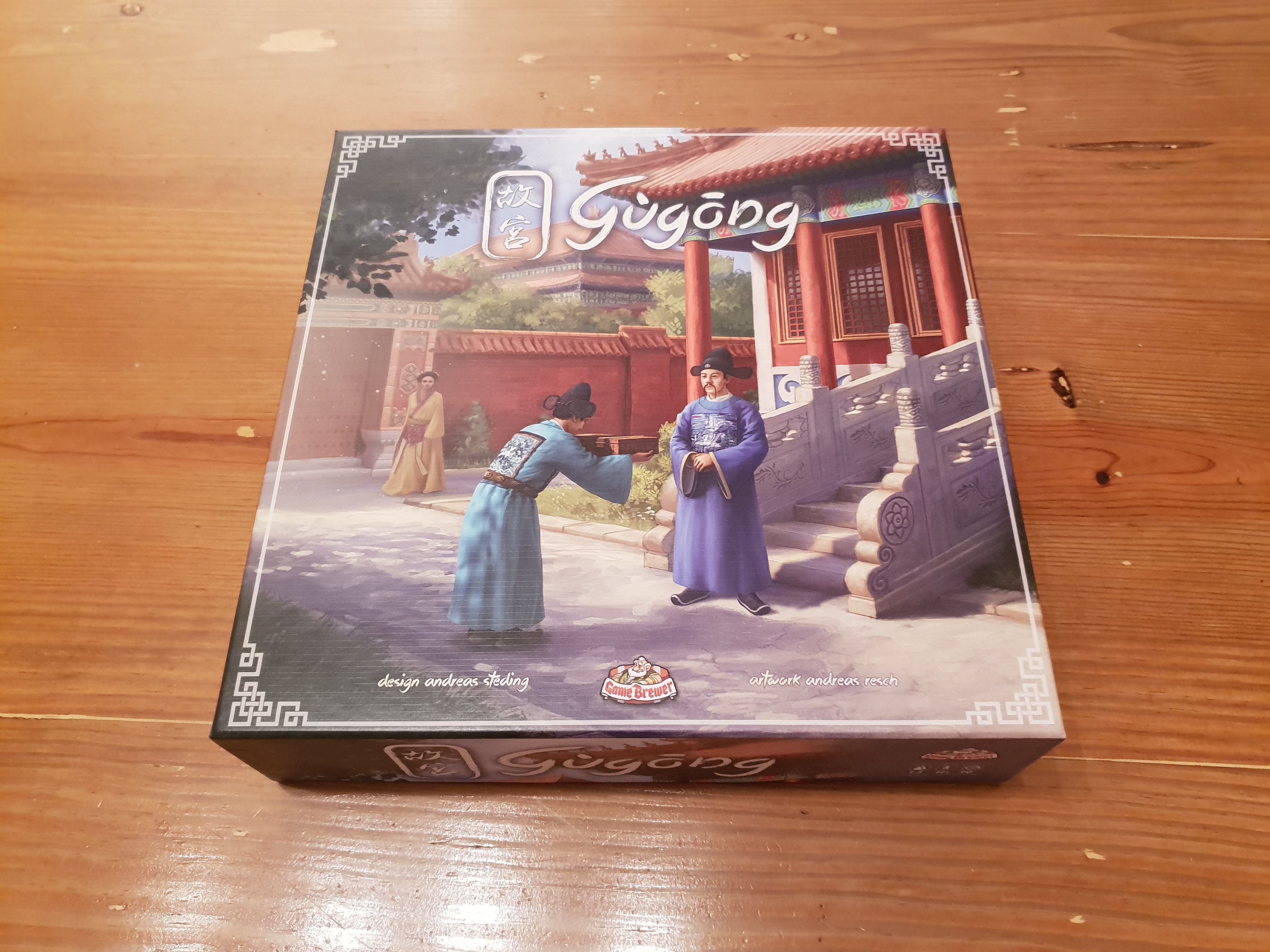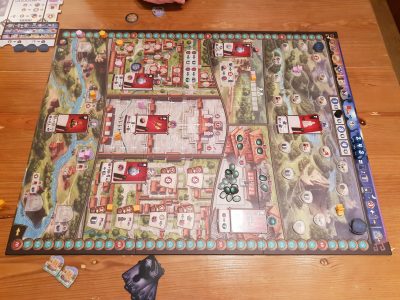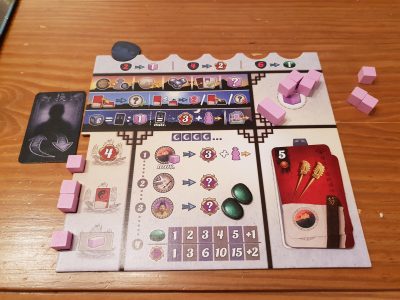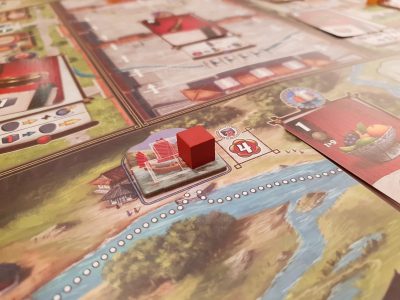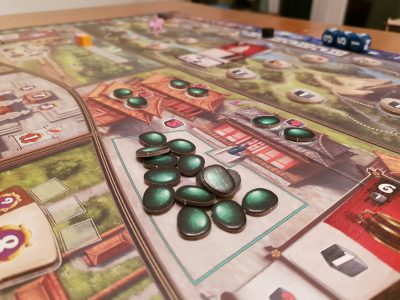Gùgōng is a brand new card placement board game from designer Andreas Steding, artist Andreas Resch and publisher Game Brewer. Based on the Former Palace, or in Chinese Gùgōng, the game is firmly themed around the glorious Forbidden City, in the heart of Beijing. The year is 1570, with China being ruled by the Longqing Emperor as part of the Ming Dynasty. Using corruption of officials as a core mechanism, 1 – 5 players will be taking up the roles of chinese families attempting to gain influence and power. However, does the weight of the game offer something to puzzle through or put up a Great Wall like barrier to playing? Let’s find out!
To set up Gùgōng each player takes from the box three ships, 12 standard and one double servant cubes, an intrigue marker, a travel marker, an envoy and a player board of a their chosen colour. Placing the double sided board in the center of the table, the side dependant on the player count, starting cards are placed onto the 7 action slots. A range of tokens for degrees and travel locations are randomised and added. Then, Players get a starting hand of four cards and place 6 of their workers into an available pool. Finally, the destiny dice are rolled – ready for the end of the round.
The core mechanism of Gùgōng is gift exchanging, a way of action selection that combines a worker placement logic with hand management. On a turn the player chooses a card from their hand and uses it to replace a card on one of the action spaces. Regardless of the specific action, if the number is higher the action is taken for free. There is a special caveat that sees a 1 beating a replaced 9. If the card being replaced has a higher or equal number, the player still has an option to take the action. By discarding an extra card, or two servant cubes, the action can be taken. Replaced cards are then put onto the players discard pile for use in the next round. Towards the end of the round players may not be able to afford this, or want to, in this case they simply replace a card on the board, with the replaced card going to their discard pile and their turn ending.
Despite being a huge game board only 7 actions are available, with some overlapping. By visiting the Palace players can move their envoy closer to the palace, paying a servant to advance twice and move one step up the intrigue track. Envoys are extremely important as if your envoy doesn’t reach the palace your total score is zero for the game. Next up players can visit the intrigue area to up their intrigue rating, used to break all ties including at the end of the game. Spending a servant here will allow three moves up the tracker instead of just one.
Going to the Great Wall, servants can be spent to help maintain the wall. When the section of wall is complete the player with majority not only gains 3 victory points they also move their envoy once. Their cubes are also returned to their general (not available) pool. Everyone involved can then trade intrigue points for things like worker cubes or even jade. Players can also gain jade by visiting the jade market. Here, by spending a denoted number of servants, the player obtains the cheapest jade stone, with victory points earnt at the end of the game for jade collected.
Visiting the Grand Canal sees the player either spawn a boat with 1 cube on it at the start of the river or add a cube to a boat they already have in play, with the option to pay to put two cubes onto a boat. Boats need to be filled by three workers before they are usable, with the ability depending on the river location. The option are: 4 victory points, available 3 times; an additional card, available twice and a double servant piece, available once. Extra cards mean more turns each subsequent round so can be helpful, while the double servant piece can be used in the place of two regular servent cubes.
Decrees come in three types, with two of each level used each game despite there being five of each type included. The level one decrees give bonuses each morning, from moving your envoy to gaining an additional servant cube. Level two decrees give cost reductions to different actions such as spending less servants to fund future decrees. Level three decrees are all about points, though each type gains players some points. These are larger scoring either directly offering points or ways to gain points at the end of the game.
The final action type at the top of the board is to move your travel marker. Moving around the top of the board, visiting areas around Beijing, gains bonuses – from points to performing other actions on the board. This can unlock actions which otherwise have high numbered gift cards in front of them. These tokens are randomised but even after being claimed provide a benefit. At any point you can trade in 2 of these tokens for a servant cube, 4 for 2 victory points or 6 for a jade stone.
Play continues around the table with each player swapping a card until everyone has run out. At the end of a round players first see if any of their discard cards match the values on the destiny dice rolled at the beginning. For each matching value a servant cube is added to your available pool for the next round. Whoever matched the most also gains 3 victory points and their envoy moves one space. The cards you discarded are then your hand for the next round, so there is plenty to pre-plan for. The final thing to do is for the boats to sail one stage down the Grand Canal.
Unless that was the fourth and final round, setup for the next round begins with players gaining four servants, not the starting six, followed by any morning bonuses from decrees. When the final round has occurred the Great Wall is scored as if it was finished. Points are then awarded for level 3 decrees, obtained Jade and the order players reached the palace. Any players that failed to get their envoy to the palace are eliminated, with the player with the highest score winning.
Differing ways to score is part of the puzzle that gamers will have to fight with, not just reacting to what opponents do. Jade scores exponentially more points per stone collected, up to 5 offering 15 points. This being said, there is always the constant drive for players to move their envoy towards the Palace, giving something for players to fight over. Fighting not with taking worker placement spots but inflating the card value present to hinder others.
Upon initial inspection the board is covered with a daunting level of iconography, to the extent the game looks a lot more complicated than it actually is. A lot of the many symbols are repeated across the different actions and a round into a game players soon realise their choices are between 7 simple actions. This isn’t to say Gùgōng is a light game. The way these simple actions interact or trigger one another adds complexity. This is the right kind of complexity, leaving players not confused with what to do but left to calculate optimal turns.
As a natural extension of this, AP (analysis paralysis) prone players beware, Gùgōng may falter for you. The central mechanic is incredibly simple, you swap a card with one on the board. The consequences though cascade throughout the game; leaving you with a particular set of cards for the next round, as well as opening up or closing opportunities for opponents. This combined with the choice of 7 actions can slow the game down and this is when down time becomes an issue.
While this review is based upon the regular, non-deluxe, edition it is hard not to stare in wonder at the upgraded components left out of the box. Nevertheless, the regular edition has very strong components. The board is beautifully illustrated with different locations and angles of the Forbidden City and surrounding countryside. The gift cards hold the theming well, featuring different goods that are associated with the era and location. One aspect that lets the game down is the usage of servants. Using simple cubes as servants, and the way they are discarded arbitrarily to do actions, makes them rather instantly become just resources to throw away. Whilst rich families of the time may have felt comfortable with this, it is odd to take a step back and see the game revolving around spending people after exchanging gifts.
Gùgōng firmly falls into the category of games where there is so much to do but not enough time to do it. Some titles use this limitation perfectly to give players the option of what to do – specialising in each game. In Gùgōng this feels overly restrictive as players are forced to move their envoy towards the palace. Decrees can change the dynamic of the game a lot. In one game one can be snapped up as it provides envoy movement each morning. In another game resources must be spent on moving the envoy itself, so these are neglected. Removing the envoy requirement the feeling of not enough time would be retained. However, it would allow gamers to truly test out different paths to victory, rather than do anything to move their envoy and merely dabble in the rest. The potential for different routes is there but the envoy rule stops them in their tracks, resulting in the game having a samey feeling after a few plays.
Having been fortunate enough to visit the Forbidden City in 2018 imagine my excitement at a board game themed around the iconic site. Since arriving Gùgōng has hit the table a number of times. It is easy to say I’ve not been let down by the theming, nor the central card swapping mechanic. Nevertheless, past a handful of plays one game starts to feel like the next, making the want for it to hit the table dwindle. On top of this, due to the down time I’d simply not want to play with the full player count. There are many interesting elements, it is a shame a few rules get in the way of the game excelling. For those wanting to try something different don’t be completely put off but Gùgōng is more a game to play a few times than one to become a game night staple.
[Editor’s Note: Gùgōng was provided to us by Asmodee UK for review purposes. The game is available from your friendly local board game stores, find your local store here]

